In-market vs Affinity audience (Differences & Similarities)

For any business that wants to expand, there are several ways to reach its target audience.
Those ways can differ from one another depending on how Google categorizes audiences.
In this article, we are going to see two of those audience targeting methods, in-market vs affinity audience, see their differences and similarities.
So, let’s get started…
How do they work?
In-market audience targets people who are actively searching for particular products or services and they have a high intent to make a purchase.
The people might not have a passion for that target industry, but they are currently in the market for the products or services offered to them.
Affinity audience targets those who have a passion and strong interest in a certain industry.
They might not have a high intent to make a purchase at present, but once you familiarize your brand to them, they might be a long-lasting source of revenue for your business in the coming future.
Similarities
In-market and affinity audiences both start their journey at the higher part of the sales funnel who have an interest in a certain subject or industry.

Let’s cover their similarities in more detail.
Adding audiences to campaigns/ad groups
You can add both audiences to your campaigns or ad groups in the same manner.
To add audiences to your existing campaigns or ad groups, click on the Audiences section, on the left side of the Google ads interface, and by clicking on Browse, you can find both targeting options.
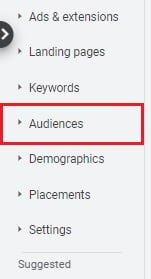
When creating a new campaign, you can find the audiences by clicking a dropdown named Audiences.
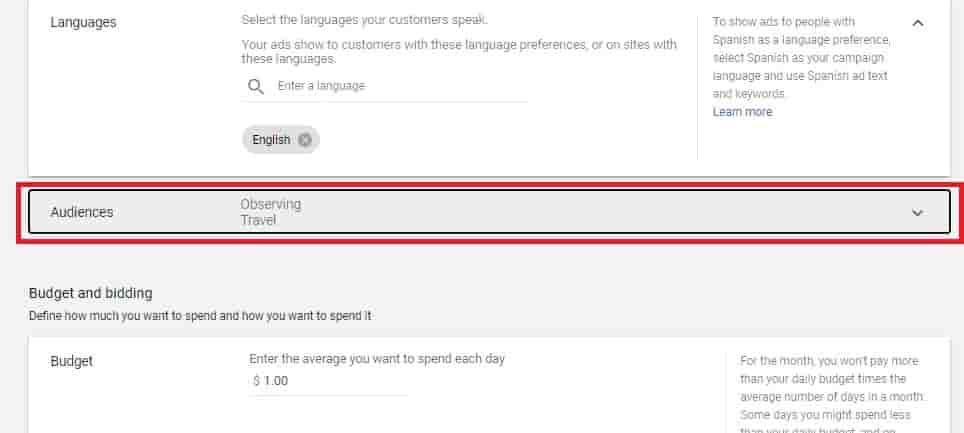
Feeding lower part of the conversion funnel
Neither of the audience targeting methods can convert people immediately, at least most of the time.
Of course, there are instances you can only run audience targeting methods and they can pay off.
But, the purpose of running them is mostly to raise brand awareness among your target audience and bringing them to the lower end of the funnel while at the same time converting some of those people along the way.
Once it reaches the bottom of the funnel, the rest is done through other ways like remarketing to the previous website visitors.
However, the two targeting methods have also differences in which parts of the funnel they lie and that we are going to see in the coming sections.
Types of campaigns
They both are available for Search, Display, Video, Gmail, Shopping, and Discovery campaigns.
Differences
If you want to take a more targeted approach and reach people with purchase intent, then in-market audience targeting is a better option. If you want to raise brand awareness and reach people who have a strong interest in your industry, then affinity audience targeting is the way to go.
What you want to focus on?
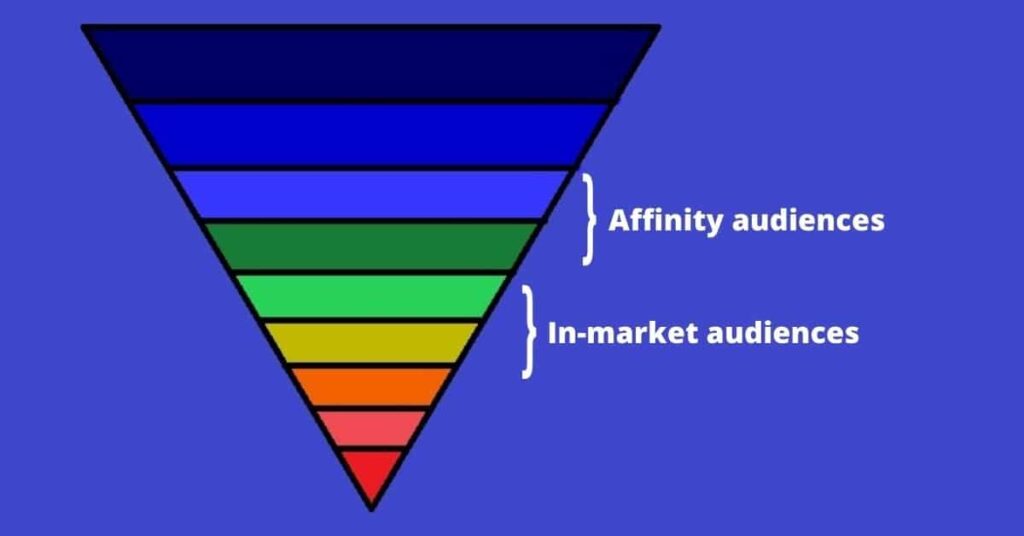
As you can see from the picture in-market audiences are a little closer to conversion
(But, keep in mind, here, it is compared to affinity audience only, not the other audience targeting options).
You can use them to achieve faster results and advertise your products to people who are in the consideration stage. So, there is a higher chance to get conversions with this type of targeting.
Affinity audience can be used by businesses who have a bigger budget or who are new to the business and want to reach as many people as possible.
Differences in interests
If you target a group who have a passion for the products in your industry, they can become your customers for a long period of time. Affinity audience targeting enables you to reach these kinds of people.
On the other hand, with in-market audiences, you can target people with short-term interests who are in the market for your products. They have a higher probability of converting because they are researching products or services and actively considering buying.
Size of the Audiences
The reason why affinity audience is too broad because it targets more generic audience segments. It has only 142 audience segments to target (download full list here. So, the ads you are serving may not be too targeted.
Whereas in-market audience targets 780 audience segments (download full list here. It is much more specific and every segment has more sub-segments to target.
For example, if you take an interest group, which is available for both, i.e. people interested in Travel, affinity audience has only 2 sub-segments.

- Business Travelers
- Travel Buffs
And if you choose any one of those sub-segments, Google ads estimates your ads to receive more than 10 billion weekly impressions.
However, in-market audience has more than 20 sub-segments to target in the Travel segment.
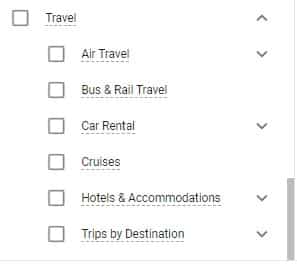
In this example, you can choose Travel, then its sub-segment Car Rental, then from it choose Minivan & SUV Rental. And that brings you less than 10 million weekly impressions for your ads to target.
This is a much more targeted approach and can increase the relevancy of your ads significantly compared to targeting affinity audiences.
How does Google categorize these audiences?
When reading about audience targeting, it may bring another question. How does Google know which audience segment a particular person should be included?
Like with other audience targeting methods, Google takes into account the following user interactions when categorizing in-market and affinity audiences:
- Search query – what someone searches for on the Google search results page
- Browsing activity – website visits, watching videos, app downloads, etc.
- Frequency of interaction – how often does someone visit particular websites, watch videos, download apps related to a certain industry
- Clicking ads – which kind of ads someone clicks would also show their area of interest
Let’s see an example of how your online behavior would determine to which category you could be added?
Imagine, you decide to travel on your vacation to Asia-Pacific. You start to research trips to Australia. So, you are checking the prices of Air tickets, Hotel prices, and you are planning to book your trip in advance.
At this stage, Google may include you in the in-market audience list, because you are actively researching and ready to take an action.
After you have returned from your trip with a good experience, you decide to travel to other countries as well on your every vacation.
So, every time before going somewhere, you start doing your research months before by watching YouTube videos, reading blogs about other countries.
Now, naturally, you are developing a passion for traveling and Google also realizes that and adds you to the list of affinity audiences. As a result, whenever you browse the internet or watch any videos, you may come across ads that are related to traveling.
Custom audience vs in-market audience
Google’s formerly known Custom Affinity and Custom intent audiences combined into one Custom audiences. With it, you can create much more specific and targeted audiences than just standard affinity audiences.
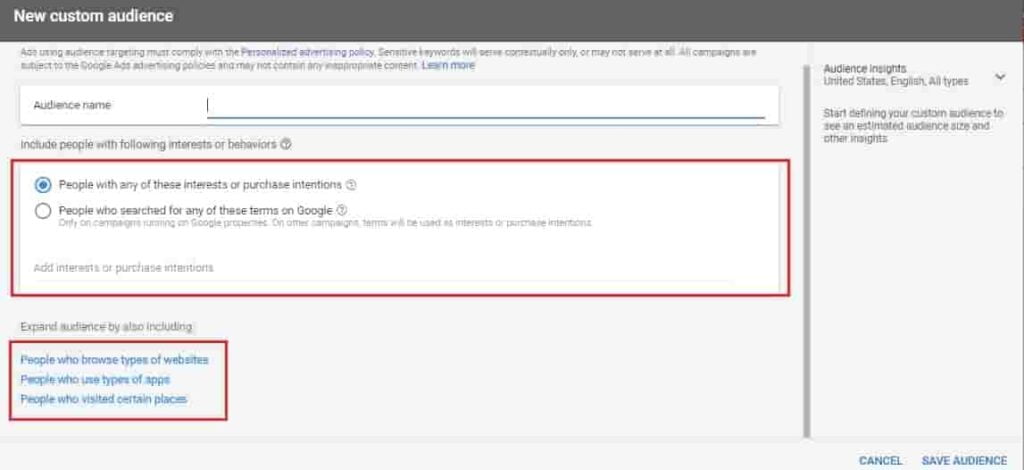
Remember, we said you have up to 780 segments to target with in-market audiences. With custom audiences, you can make unlimited combinations and be much more in-depth on your targeting approach.
That makes it a much better option than in-market audiences if you know how to find your target audiences.
Case studies
Here is a little case study, with a formerly known custom affinity audience (now custom audience). A campaign managed to acquire conversions almost 5 times less than the price of search activities.
Leading online retailer Wayfair increased its short-term conversion behavior by 10-30% when using in-market audiences on the Google Display Network.
Conclusion
As you can see, Depending on your business goals targeting methods can change.
Do you have a high ad budget, so that you can reach more people? Or you want to emphasize more specific niches of your industry with less audience to target?
If you combine those goals with user demographics, locations, smart bidding, and remarketing strategies, it can lead to better overall performance.
Now, which one you think is better for your business, affinity, or in-market audience?
Let me know in the comments section below…
For Google ads management, you can contact me through the Contact page.

